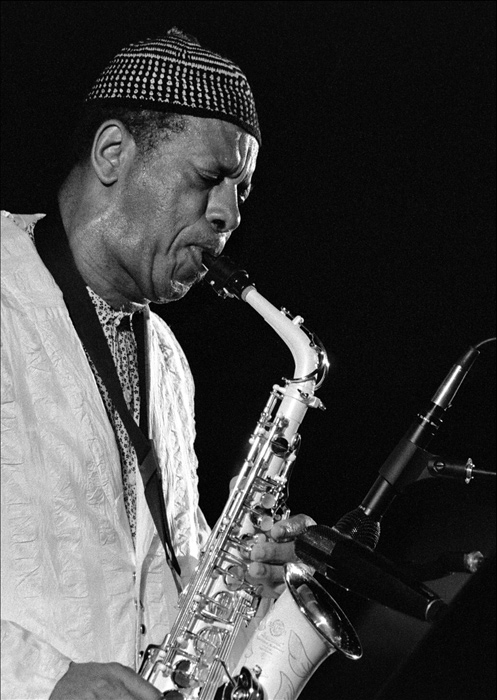|
Solo In Japan (album)
''Solo in Japan'' is an album by American jazz saxophonist Charles Gayle recorded on July 6 and 7, 1997 for P.S.F. Records (PSFD-94). Reception The authors of the ''Penguin Guide to Jazz Recordings'' awarded the album 4 stars. Writing for Acoustic Levitation, Carlos Gómez included the album in a "Best of 2012" list, and commented: "Mr. Gayle's character 'Streets' plays in a pure and touching mood. Solo pieces on tenor and soprano saxophone or piano. You don't need to think as you listen; go with what you feel." Track listing # "Come Ye"—7:59 # "Walking Nearer"—15:01 # "Praise God"—9:46 # "Christ Changes You"—11:59 # "Woe and Joy"—11:36 Recordings Track 1,2,3,4 were live-recorded at Jazz-Cafe ''Narcissus'' in Shinjuku, Tokyo on July 6, 1997, and Track 5 was recorded at ''BarBer Fuji'' that is not only a barber but a live house in Ageo-city, Saitama on July 7, 1997. No voices or claps is heard but this is the live recordings. Personnel *Charles Gayle—tenor s ... [...More Info...] [...Related Items...] OR: [Wikipedia] [Google] [Baidu] |
Charles Gayle
Charles Gayle (born February 28, 1939) is an American free jazz musician. Initially known as a saxophonist who came to prominence in the 1990s after decades of obscurity, Gayle also performs as pianist, bass clarinetist, bassist, and percussionist. Biography Charles Gayle was born in Buffalo, New York. Some of his history has been unclear due to his reluctance to talk about his life in interviews. He briefly taught music at the University at Buffalo before relocating to New York City during the early 1970s. Gayle was homeless for approximately twenty years, playing saxophone on street corners and subway platforms around New York City. He has described making a conscious decision to become homeless: "I had to shed my history, my life, everything had to stop right there, and if you live through this, good, and if you don't, you don't. I can't do the rent, the odd jobs, the little rooms, scratchin', and all that, no!" At the same time, this allowed Gayle to devote most of his t ... [...More Info...] [...Related Items...] OR: [Wikipedia] [Google] [Baidu] |
Free Jazz
Free jazz is an experimental approach to jazz improvisation that developed in the late 1950s and early 1960s when musicians attempted to change or break down jazz conventions, such as regular tempos, tones, and chord changes. Musicians during this period believed that the bebop, hard bop, and modal jazz that had been played before them was too limiting. They became preoccupied with creating something new and exploring new directions. The term "free jazz" has often been combined with or substituted for the term " avant-garde jazz". Europeans tend to favor the term " free improvisation". Others have used "modern jazz", "creative music", and "art music". The ambiguity of free jazz presents problems of definition. Although it is usually played by small groups or individuals, free jazz big bands have existed. Although musicians and critics claim it is innovative and forward-looking, it draws on early styles of jazz and has been described as an attempt to return to primitive, of ... [...More Info...] [...Related Items...] OR: [Wikipedia] [Google] [Baidu] |
Jun Tanaka (producer) , American-born British Japanese television chef
{{hndis, Tanaka, Jun ...
Jun Tanaka may refer to: * Jun Tanaka (poet) (1890–1966), poet in Showa period Japan * Jun Tanaka (footballer) (born 1983), Japanese football player * Jun Tanaka (chef) Jun Tanaka (born 18 November 1971Cowen, Ruth"The Contender"''The Guardian''. Friday 23 November 2001.) is an American-born Japanese-British television chef, best known for presenting Channel 4's ''Cooking It'' as well as appearing in ''Saturd ... [...More Info...] [...Related Items...] OR: [Wikipedia] [Google] [Baidu] |
The Penguin Guide To Jazz
''The Penguin Guide to Jazz'' is a reference work containing an encyclopedic directory of jazz recordings on CD which were (at the time of publication) currently available in Europe or the United States. The first nine editions were compiled by Richard Cook and Brian Morton, two chroniclers of jazz resident in the United Kingdom. History The first edition was published in Britain by Penguin Books in 1992. Every subsequent two years, through 2010, a new edition was published with updated entries. The eighth and ninth editions, published in 2006 and 2008, respectively, each included 2,000 new CD listings. The title took on different forms over the lifetime of the work, as audio technology changed. The seventh edition was known as ''The Penguin Guide to Jazz on CD'' while subsequent editions were titled ''The Penguin Guide to Jazz Recordings''. The earliest edition had the title ''The Penguin Guide to Jazz on CD, LP and Cassette''. Richard Cook died in 2007, prior to the co ... [...More Info...] [...Related Items...] OR: [Wikipedia] [Google] [Baidu] |
Penguin Guide To Jazz Recordings
''The Penguin Guide to Jazz'' is a reference work containing an encyclopedic directory of jazz recordings on CD which were (at the time of publication) currently available in Europe or the United States. The first nine editions were compiled by Richard Cook and Brian Morton, two chroniclers of jazz resident in the United Kingdom. History The first edition was published in Britain by Penguin Books in 1992. Every subsequent two years, through 2010, a new edition was published with updated entries. The eighth and ninth editions, published in 2006 and 2008, respectively, each included 2,000 new CD listings. The title took on different forms over the lifetime of the work, as audio technology changed. The seventh edition was known as ''The Penguin Guide to Jazz on CD'' while subsequent editions were titled ''The Penguin Guide to Jazz Recordings''. The earliest edition had the title ''The Penguin Guide to Jazz on CD, LP and Cassette''. Richard Cook died in 2007, prior to the comp ... [...More Info...] [...Related Items...] OR: [Wikipedia] [Google] [Baidu] |
Tenor Saxophone
The tenor saxophone is a medium-sized member of the saxophone family, a group of instruments invented by Adolphe Sax in the 1840s. The tenor and the alto are the two most commonly used saxophones. The tenor is pitched in the key of B (while the alto is pitched in the key of E), and written as a transposing instrument in the treble clef, sounding an octave and a major second lower than the written pitch. Modern tenor saxophones which have a high F key have a range from A2 to E5 (concert) and are therefore pitched one octave below the soprano saxophone. People who play the tenor saxophone are known as "tenor saxophonists", "tenor sax players", or "saxophonists". The tenor saxophone uses a larger mouthpiece, reed and ligature than the alto and soprano saxophones. Visually, it is easily distinguished by the curve in its neck, or its crook, near the mouthpiece. The alto saxophone lacks this and its neck goes straight to the mouthpiece. The tenor saxophone is most recognize ... [...More Info...] [...Related Items...] OR: [Wikipedia] [Google] [Baidu] |
Soprano Saxophone
The soprano saxophone is a higher-register variety of the saxophone, a woodwind instrument invented in the 1840s. The soprano is the third-smallest member of the saxophone family, which consists (from smallest to largest) of the soprillo, sopranino, soprano, alto, tenor, baritone, bass, contrabass saxophone and tubax. Soprano saxophones are the smallest and thus highest-pitched saxophone in common use. The instrument A transposing instrument pitched in the key of B, modern soprano saxophones with a high F key have a range from concert A3 to E6 (written low B to high F) and are therefore pitched one octave above the tenor saxophone. There is also a soprano saxophone pitched in C, which is uncommon; most examples were produced in America in the 1920s. The soprano has all the keys of other saxophone models (with the exception of the low A on some baritones and altos). Soprano saxophones were originally keyed from low B to high E, but a low B mechanism was patented in 188 ... [...More Info...] [...Related Items...] OR: [Wikipedia] [Google] [Baidu] |
Piano
The piano is a stringed keyboard instrument in which the strings are struck by wooden hammers that are coated with a softer material (modern hammers are covered with dense wool felt; some early pianos used leather). It is played using a musical keyboard, keyboard, which is a row of keys (small levers) that the performer presses down or strikes with the fingers and thumbs of both hands to cause the hammers to strike the strings. It was invented in Italy by Bartolomeo Cristofori around the year 1700. Description The word "piano" is a shortened form of ''pianoforte'', the Italian term for the early 1700s versions of the instrument, which in turn derives from ''clavicembalo col piano e forte'' (key cimbalom with quiet and loud)Pollens (1995, 238) and ''fortepiano''. The Italian musical terms ''piano'' and ''forte'' indicate "soft" and "loud" respectively, in this context referring to the variations in volume (i.e., loudness) produced in response to a pianist's touch or pressure on ... [...More Info...] [...Related Items...] OR: [Wikipedia] [Google] [Baidu] |
1997 Albums
File:1997 Events Collage.png, From left, clockwise: The movie set of ''Titanic (1997 film), Titanic'', the List of highest-grossing films, highest-grossing movie in history at the time; ''Harry Potter and the Philosopher's Stone'', is published; Comet Hale-Bopp passes by Earth and becomes one of the most observed comet, comets of the 20th century; Golden Bauhinia Square, where sovereignty of Hong Kong is Handover of Hong Kong, handed over from the United Kingdom to the People's Republic of China; the 1997 Central European flood kills 114 people in the Czech Republic, Poland, and Germany; Korean Air Flight 801 crashes during heavy rain on Guam, killing 229; Mars Pathfinder and Sojourner (rover), Sojourner land on Mars; flowers left outside Kensington Palace following the death of Diana, Princess of Wales, in a car crash in Paris., 300x300px, thumb rect 0 0 200 200 Titanic (1997 film) rect 200 0 400 200 Harry Potter rect 400 0 600 200 Comet Hale-Bopp rect 0 200 300 400 Death of Diana ... [...More Info...] [...Related Items...] OR: [Wikipedia] [Google] [Baidu] |




